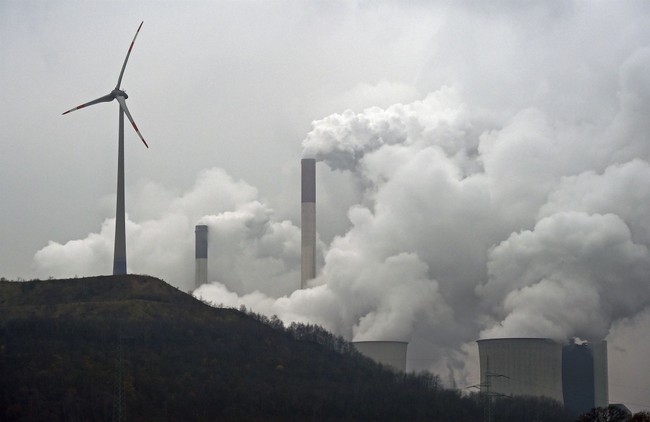We support our Publishers and Content Creators. You can view this story on their website by CLICKING HERE.

German coalition government may not survive the night.
From trusted sources in Berlin.
Fallout from election of Trump, who asking other things is Germany’s most famous energy critic.
Here is the chance needed to save Germany’s nuclear plants.
— Mark Nelson (@energybants) November 6, 2024
Advertisement
THE WIND DIED ALONG WITH THE GOVERNMENT COALITION
And the cold weather came in just as it did. Part of the reason the government fractured? Ruinous green energy policies which exploded the price of electricity thanks to transitioning to unreliable renewables.
…The Greens are woke on steroids. Some years ago, their parliamentarians even floated the idea of legalizing pedophilia and incest. They have not met a progressive idea they do not like. Hence, they enjoy the support of garden variety radicals at universities and the youth vote.
The Greens support anything from deindustrialization and de-carbonization to transgenderism and abortion on demand. They embrace the inefficient pipe dream of “clean” energy — solar and wind in particular. On the other hand, they of course hate nuclear power that could save shivering Germans from Europe’s frigidity and high energy costs.
As if to hammer home the message, as the government collapsed and the wind died away simultaneously, what happened to the market price of electricity?
Through the roof.
Bro, Europe might be cooked, doesn’t even have strategic autonomy from clouds, much less Russia and the USA 😭 https://t.co/bSEWwNKSbD pic.twitter.com/g0qrrOv63m
— Mark Nelson (@energybants) November 7, 2024
Usage for homes, industry, and backup power generation started drawing down natural gas stockpiles well before forecast, and those hadn’t been completely topped off for winter yet.
Your November reminder to hope for a windy, wet, and warm winter. The first Dunkelflaute of the 2024-25 season forced a large withdrawal of gas from storage.
With storage at ~95% at the start of the season, one Dunkelflaute and/or cold snap isn’t a problem. Multiple will be.
— Javier Blas (@JavierBlas) November 7, 2024
Advertisement
A dunkelflaute hit. The dark, gloomy periods with little to no wind and weak sun rays are a seasonal natural occurrence in Germany. Ergo one which you thought might have figured larger in planning during their mad dash to a wind-driven ‘renewable Nirvana.’
ENERGIEWENDE UBER ALLES
…And yet, Germans allowed their government to shut down their nuclear reactors in favor of Green energy.
…Earlier this month, another Dunkelflaute took place and coal served as the main back up to keep Germany running. Some might hope batteries can step up to replace the coal, but batteries aren’t synonymous with dispatchable baseload energy—you have to charge batteries with power from the grid, so they don’t produce “new” power, they only move power around in time and space.
And even if batteries could cover Dunkelflautes, which can often last between 50 and 150 hours, they’re way too expensive. According to the engineer and energy analyst Hügo Krüger, covering a 10 hour Dunkelflaute with batteries priced at $200 kW/hr would cost $296 billion upfront, plus $59.2 million (add this on again every ten hours as needed). Remember: winter comes every year.
Yes, enthusiasm overrode caution, and, as most dunkelflautes are of minor proportion, the climate cultists running the country dismissed the issue out of hand. They were bitten badly by several longer durations last year, but they squeaked through.
The dunkelflaute of 6 November had other ideas, though.
It decided to hang around.
Within a few days experts were already warning that the natgas supplies would be in great peril if withdrawals kept up at the pace they were currently and if that dang wind didn’t start to blow.
CHART OF THE DAY: The storage withdrawal season has started for the European gas market. The last few days have witnessed seasonally large withdrawals.
In August, I warned in this @Opinion column how “enough” gas inventories could still be insufficient: https://t.co/PCsC6n2nIh pic.twitter.com/mCEx9XQYwY
— Javier Blas (@JavierBlas) November 8, 2024
Advertisement
Which it didn’t.
The air stayed still across Northwest Europe.
Dunkelflaute conditions are persisting over north-west Europe (6th consecutive day), curtailing wind power generation.
Gas + coal + oil + firewood accounting for 50-70% of total electricity generation in Germany / UK / Netherlands.
Merci monsieur Messmer
— Javier Blas (@JavierBlas) November 9, 2024
Four days and counting.
Good Morning from #Germany, where electricity prices have soared this week due to a period of “dark doldrums.” With foggy weather & hardly any wind, renewable energy production dropped significantly. As a result, Germany had to import more electricity than ever before. pic.twitter.com/lId3i44umG
— Holger Zschaepitz (@Schuldensuehner) November 10, 2024
Things picked up a bit on the 11th, but nowhere near what the Germans needed.
By the 15th, things were looking desperate, even as new February elections were being scheduled by wounded Olaf Scholz.
As Germany attempts to negotiate with Putin, they’ve had almost no wind or solar power this entire month.
Built 166 GW of wind and solar and are getting next to NOTHING from in November.
Whatever Gods German energy ministers pray to for good weather, they need new ones. pic.twitter.com/yvtboh6ayG
— Mark Nelson (@energybants) November 15, 2024
It wound up being a twelve-day-long wind drought.
Markus Krebber, CEO of RWE (the German electrical multinational), posted on LinkedIn (Maybe so he could say what he had to say without the world seeing?) what appeared to industry insiders to be pretty desperate “plea” for more “secure” power providers.
German utility execs who champion the Energiewende are starting to panic after this month’s shocking 12-day wind drought.
RWE CEO Markus Krebber posted a desperate plea for more “secure” power supplies this morning on LinkedIn.
The situation is coming to a breaking point. https://t.co/8zEtJKQidS pic.twitter.com/Xj9vkIHnyI
— Mark Nelson (@energybants) November 21, 2024
Advertisement
At the beginning of this month, the German electricity supply reached its limits. In the evening hours of November 6, the price of electricity rose extremely quickly and sharply – to more than 800 euros per megawatt hour. This made it around ten times more expensive than usual. Then there was a brief outcry, but it did not last long. Meanwhile, the whole thing was more than just a warning shot. Phases in which wind and solar only produce limited electricity (so-called dark doldrums) are quite normal – they occur again and again, so we must be prepared. To ensure stability – the stability of the system as a whole and the stability of the price in particular. Because: These very high prices are an absolutely sure indication of the state of security of supply in Germany. They are the result of too little supply. So let’s take a look at the figures from November 6: Demand was around 66 GW. This was covered by domestic production (around 53 GW) and imports (around 13 GW). Almost the entire domestic supply was available (only around 4 GW was not, although this is not unusual). In terms of imported power, only around 3 GW of interconnector capacity was not available (also not unusual). In concrete terms, this means that the same situation would not have been possible on another day with a higher peak load. For example, in January. The highest electricity demand of the year was on January 15, at more than 75 GW. And thus almost 10 GW more than on November 6! And in Germany we have been acting (for years) as if the question of expanding secure capacity was something that can be postponed. But we can already see very clearly today what happens when you switch off power and do not provide a backup for renewables. No, we have no more time, quite the opposite. Time is running out and expansion is urgent – and not just since this month.
Advertisement
Now, mind you – this guy and his companies were yuge energiewende proponents – all about cashing in on the deal.
SO into it, they own the lignite coal mines that provide the fuel for the back-up electricity generation plants and the nuclear energy plants that were just shut down which could have avoided this entire debacle.
Mind you, RWE is also accused of prematurely making sure that the decommissioned nuclear facilities are in no shape to be fired back up in an emergency…or the death of Green drifting. Their lignite operation is too valuable by half.
…Rumors are bubbling up to people in the business that RWE has already made a move to protect its nascent goldmine in the coal shaft.
Still waiting on government approval to begin dismantling the reactors, RWE has spiked the rods in one of them, just in case anyone had any plans to fire those bad boys back up.
…Slick, no?
…RWE claims to be fully committed to renewables and hydrogen, but they’re investing money to significantly expand an immense lignite (“brown”) coal mine, even tearing down a wind farm to do so!
By destroying their nuclear plant as fast (or faster?) than the law allows, RWE helps lock in its big lignite coal investments ahead of a possible reversal in German nuclear policy.
And now it turns out even the coal-fired power plants were barely enough and made utilities so hideously expensive that Krebber is crying ‘uncle.’
Using up available stockpiles of natgas has an effect on the financial picture of both private citizens and industry.
US natural gas price
2019: $2.53/mmbtu
2023: $2.67Europe natural gas price
2019: $4.801
2023: $13.21Abundant shale gas has helped keep US power prices in check (there are of course other factors)
Meanwhile, Europe lost Russian pipeline gas https://t.co/0pNbKNKaJ9
— Stephen Stapczynski (@SStapczynski) November 13, 2024
Advertisement
THIS IS WHAT ENERGY INDEPENDENCE LOOKS LIKE
No place but up for Europe.
European nat gas benchmark TTF ends the day at €46.90 per MWh, the highest closing in 12 months (that’s ~$14.5 per mBtu). European gas prices have **doubled** since their 2024 low point in Feb as the region eats throughout its inventories quite quickly due low wind and cold.
— Javier Blas (@JavierBlas) November 18, 2024
No one but themselves is to blame.
There’s some speculation that (when) Scholz loses, so do the Green Loons, and nuclear makes a come-back.
But they have to get through this winter to do that, and this year’s start is not very promising at all.
…Why luck? First, for two consecutive winters, Europe enjoyed a warm, wet, and windy season — perfect for both curtailing heating demand and generating lots of wind, solar, and hydro power. Second, the region faced limited competition for LNG shipments from Asia as China and others struggled to recover from the impact of the Covid-19 pandemic. Thanks to both, Europe was able to build huge stockpiles ahead of the winter. And as the cold season wasn’t as chilly as normal, there was a significant leftover reserve by the time spring arrived.
The luck has run out. The weather has turned cold, calm and dry. The Germans have a word for it: dunkelflaute — a period of windless and cloudy weather that results in little renewable production. Europe suffered a long dunkelflaute in early November, and another is likely next week. And Asia is importing more LNG, pushing up prices. In turn, Europe has been buying about a fifth less LNG than it did during the last two years. The result? Europe is dipping heavily into its gas storage. During the first two weeks of November, gas withdrawals from inventories were the second largest for that period in data since 2010. On current trends, storage levels in November will see their largest drop since 2016 for that month, double the fall seen in both 2022 and 2023.
Advertisement
Throw in a little real Russian-Ukrainian spiciness, and it could go really badly very quickly for a lot of people.

 Conservative
Conservative  Search
Search Trending
Trending Current News
Current News 







